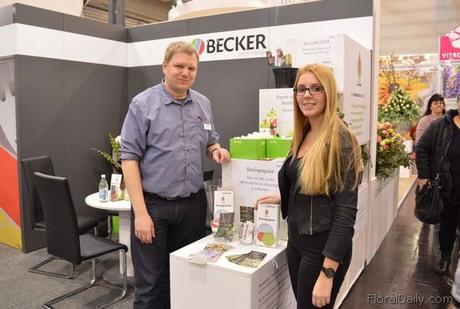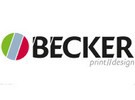"Being and becoming more environmentally friendly is a trend", says Okan Tüysüz, Sales Manager at Etiketten-Becker. Over the last years, they increasingly more often receive requests from Dutch and German growers asking for a greener solution for the entire year or a couple of weeks of the year. "There are growers who have a green marketing strategy for a certain week and therefore need environmentally friendly labels", explains Tüysüz. "So, in order to meet the growers' needs, we decided to create an ecological product that can be used as a substitute for polypropylene." At the IPM Essen 2017, where Etiketten-Becker presented the stone paper to the public for the first time, growers from all over the world showed their interest.

Tüysüz's colleagues Jonns Pfeiffenberger and Fotini Sarakatsionou presenting the stone paper at the IPM Essen in Germany.
Stone paper
Etiketten-Becker's stone paper consists of 80 percent limestone and 20 percent recycled polyethylene. This combination results in a 100 percent ecological product that can be used for several purposes, from posters, flyers to bags and is mostly used as (hang)labels and pot covers by growers. "It is a substitute for polypropylene because it is water- UV-, and tear- (more than paper) resistant. On top of that, it is also writable, even when it is wet." The paper can be printed with a thickness between 100 and 400 micron.
Production process
According to Tüysüz, not only the product itself is more environmentally friendly, the production of it is too. "The entire production is following to the 'cradle to cradle principle'" he says. "And in contrast to the production of regular paper, the production of stone paper does not require any water, cellulose, acids or bleach. And no cellulose means no cutting of trees. Moreover, the CO2 emissions are about 67 percent lower in the production of stone paper than in the production of cellulose paper."
What about the costs?
And the important question, what will it cost? "Of course, the prices for a stone paper label is higher than that of a polypropylene label, but when choosing a paper with less microns, the prices are the same and the differences minimal. A stone paper label with a thickness of 300 micron looks and costs almost similar to a PP label with 350 microns. On top of that, the cost price is still high because of the current low production volumes. However, if the volumes increase - and we expect them to do - the cost price will decrease, which means more attractive prices for our customers."
For more information
Etikette
 n -Becker OHG
n -Becker OHGOkan Tüysüz
Email: [email protected]
www.etikettenbecker.com










